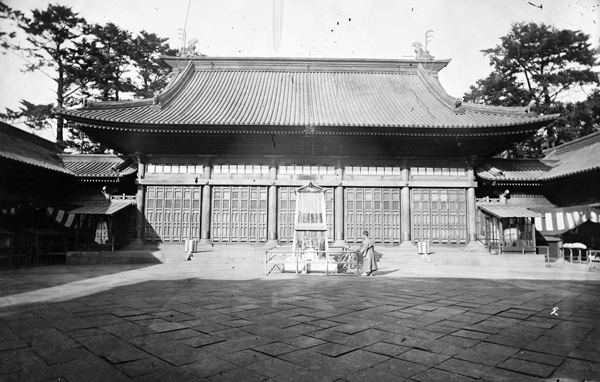1.湯島聖堂博覧会

古今珎物集覧 一曜斎国輝筆 明治時代
明治5年(1872)に一曜斎国輝によって描かれた「古今珍物集覧」という3枚組の錦絵がある。正面の建物と左右の回廊の棚に並ぶ様々な陳列品を強烈な色彩で描いた、変わりだねの1点である。画面手前には水槽に入れた山椒魚、中央に大きな黄金の鯱、正面の堂内には絵画・書跡・珊瑚・金工品、右の棚に剥製・骨格見本・額画、左の棚に染織品・漆器・楽器・陶器類などが網羅的に並べられている。実は、これがわが国における最初の博覧会の陳列風景であった。
明治5年3月10日、湯島聖堂大成殿を会場として文部省博物局による最初の博覧会が開かれた。博覧会の会期は20日間、午前9時から午後4時までの開館時間が設けられた。この博覧会の陳列品は、前年の大学南校(文部省の前身)物産会の資料を引継ぎ、さらに翌年オーストリアで開催されるウィーン万国博覧会の参加準備も兼ね、広く全国に出品を呼びかけ収集している。博覧会出品目録草稿によると陳列品は、御物はじめとする古器旧物(文化財)と剥製、標本などの天産物を中心に600件余りをかぞえ、広汎な種類の展示であったことがうかがえる。特に、大成殿中庭のガラスケースに陳列された名古屋の金鯱は観覧者の注目を集め、博覧会の人気に拍車をかけた。当事者の1人である田中芳男が後に述べているように、この博覧会は観覧者が多く混雑したため入場を制限し、対応策として会期を4月末日まで延長せざるをえなかった。博覧会の入場者総数15万人、1日平均約3,000人の観覧者が大成殿に足を運んだことになる。
明治5年の博覧会は、恒久的な展示を行なう博物館の誕生でもあった。ガラスの陳列ケースの並ぶ室内、さらにケース内の陳列品は、当時の観覧者に新鮮な印象を与えたことだろう。政府によるわが国最初の博覧会の開催、東京国立博物館はこれをもって創立・開館の時としている。

明治5年(1872)湯島聖堂博覧会の公布 湯島聖堂博覧会の観覧券

湯島聖堂大成殿
